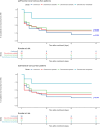Renal venous flow in different regions of the kidney are different and reflecting different etiologies of venous reflux disorders in septic acute kidney injury: a prospective cohort study
- PMID: 39656352
- PMCID: PMC11631833
- DOI: 10.1186/s40635-024-00700-0
Renal venous flow in different regions of the kidney are different and reflecting different etiologies of venous reflux disorders in septic acute kidney injury: a prospective cohort study
Abstract
Background: Acute kidney injury (AKI) is a frequent complication of sepsis. While impaired renal venous reflux indicates renal congestion, the relationship between AKI outcomes and hemodynamic parameters remains debated. This study aimed to investigate the utility of renal venous flow patterns in various regions of septic patients and to explore the association between hemodynamic parameters and renal function prognosis.
Methods: In this single-center, prospective longitudinal study, adult sepsis patients diagnosed with AKI were enrolled. Renal ultrasonography was performed within 24 h of ICU admission (D1), then repeated at D3 and D5. Patterns of proximal renal venous flow (PRVF) and intrarenal venous flow (IRVF) patterns were confirmed by two blinded sonographers. Kaplan-Meier survival analysis was used to evaluate renal prognosis, and cumulative incidence curves were generated for renal function recovery time.
Results: The study included 96 septic patients. Inconsistencies between PRVF and IRVF patterns occurred in 31.9%, with PRVF patterns being more severe in 88% of these. A relatively strong correlation was observed between PRVF and CVP, but this trend was less evident in IRVF. For RVSI of PRVF at ICU admission, the AUC to predict 28-day renal function prognosis was 0.626 (95% CI 0.502-0.750, P = 0.044), while combined PRVF and IRVF had a higher predictive ability (AUC 0.687, 95% CI 0.574-0.801, P = 0.003). The 28-day renal prognosis was poorer in the PRVF 5-day non-improvement group compared to the 3-day improvement group (P = 0.001) and 5-day improvement group (P = 0.012). Patients with a persistent monophasic PRVF pattern within 5 days had a worse prognosis than the non-monophasic group (P = 0.005).
Conclusions: Our study reveals that patterns of PRVF and IRVF are not entirely congruent, stepwise evaluation is useful in determining the intervention site for renal vein reflux disorders. Combined PRVF and IRVF had a higher predictive ability for 28-day renal function prognosis. Early improvement in renal venous congestion is crucial for better renal function prognosis. This study is registered with ClinicalTrials.gov, number NTC06159010. Retrospectively registered 28 November 2023.
Keywords: Acute kidney injury; Intrarenal venous flow; Proximal renal venous flow; Renal congestion; Sepsis.
© 2024. The Author(s).
Conflict of interest statement
Declarations. Ethics approval and consent to participate: This study was designed as a single-center prospective study conducted at Peking Union Medical College Hospital. The protocol was approved by the Ethics Committee of Peking Union Medical College Hospital (approval number I-23PJ176). Written informed consents were obtained from all participants. Consent for publication: Not applicable. Competing interests: On behalf of all authors, the corresponding author declares that there are no conflicts of interest.
Figures








Similar articles
-
Association between intrarenal venous flow from Doppler ultrasonography and acute kidney injury in patients with sepsis in critical care: a prospective, exploratory observational study.Crit Care. 2023 Jul 10;27(1):278. doi: 10.1186/s13054-023-04557-9. Crit Care. 2023. PMID: 37430356 Free PMC article.
-
Prediction of Acute Kidney Injury After Cardiac Surgery With Combined Arterial and Venous Intrarenal Doppler.Can J Kidney Health Dis. 2024 Dec 23;11:20543581241309976. doi: 10.1177/20543581241309976. eCollection 2024. Can J Kidney Health Dis. 2024. PMID: 39735690 Free PMC article.
-
Doppler-based evaluation of intrarenal venous flow as a new tool to predict acute kidney injury: A systematic review and meta-analysis.Nefrologia (Engl Ed). 2023 Dec;43 Suppl 2:57-66. doi: 10.1016/j.nefroe.2023.05.010. Epub 2024 Jan 19. Nefrologia (Engl Ed). 2023. PMID: 38245439
-
Clinical Implications of Intrarenal Hemodynamic Evaluation by Doppler Ultrasonography in Heart Failure.JACC Heart Fail. 2016 Aug;4(8):674-82. doi: 10.1016/j.jchf.2016.03.016. Epub 2016 May 11. JACC Heart Fail. 2016. PMID: 27179835
-
Intrarenal Doppler approaches in hemodynamics: A major application in critical care.Front Physiol. 2022 Oct 12;13:951307. doi: 10.3389/fphys.2022.951307. eCollection 2022. Front Physiol. 2022. PMID: 36311236 Free PMC article. Review.
Cited by
-
Assessing volume status in heart failure: The role of renal duplex ultrasound in evaluating cardiorenal morbidity and heart failure mortality.J Crit Care Med (Targu Mures). 2025 Jul 31;11(3):275-289. doi: 10.2478/jccm-2025-0029. eCollection 2025 Jul. J Crit Care Med (Targu Mures). 2025. PMID: 40765549 Free PMC article.
References
-
- Uchino S, Kellum JA, Bellomo R, Doig GS, Morimatsu H, Morgera S, Schetz M, Tan I, Bouman C, Macedo E et al (2005) Acute renal failure in critically ill patients a multinational multicenter study. JAMA 294(7):813–818 - PubMed
-
- Hoste EA, Bagshaw SM, Bellomo R, Cely CM, Colman R, Cruz DN, Edipidis K, Forni LG, Gomersall CD, Govil D et al (2015) Epidemiology of acute kidney injury in critically ill patients: the multinational AKI-EPI study. Intensive Care Med 41(8):1411–1423 - PubMed
-
- Bhardwaj V, Vikneswaran G, Rola P, Raju S, Bhat RS, Jayakumar A, Alva A (2020) Combination of inferior vena cava diameter, hepatic venous flow, and portal vein pulsatility index: venous excess ultrasound score (VEXUS Score) in predicting acute kidney injury in patients with cardiorenal syndrome: a prospective cohort study. Indian J Crit Care Med 24(9):783–789 - PMC - PubMed
-
- Ter Maaten JM, Dauw J, Martens P, Somers F, Damman K, Metalidis C, Nijst P, Dupont M, Mullens W (2021) The effect of decongestion on intrarenal venous flow patterns in patients with acute heart failure. J Card Fail 27(1):29–34 - PubMed
Grants and funding
LinkOut - more resources
Full Text Sources

